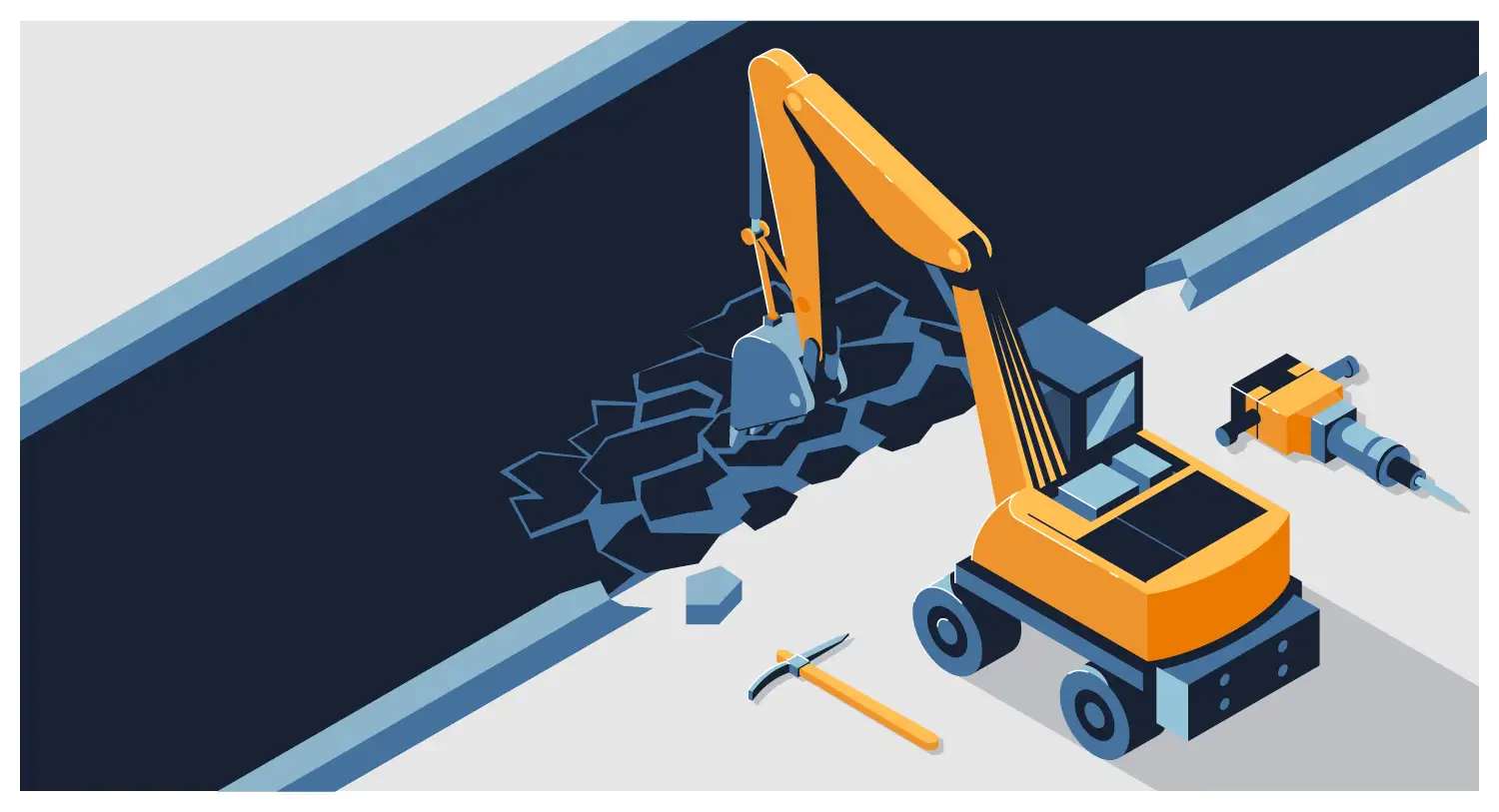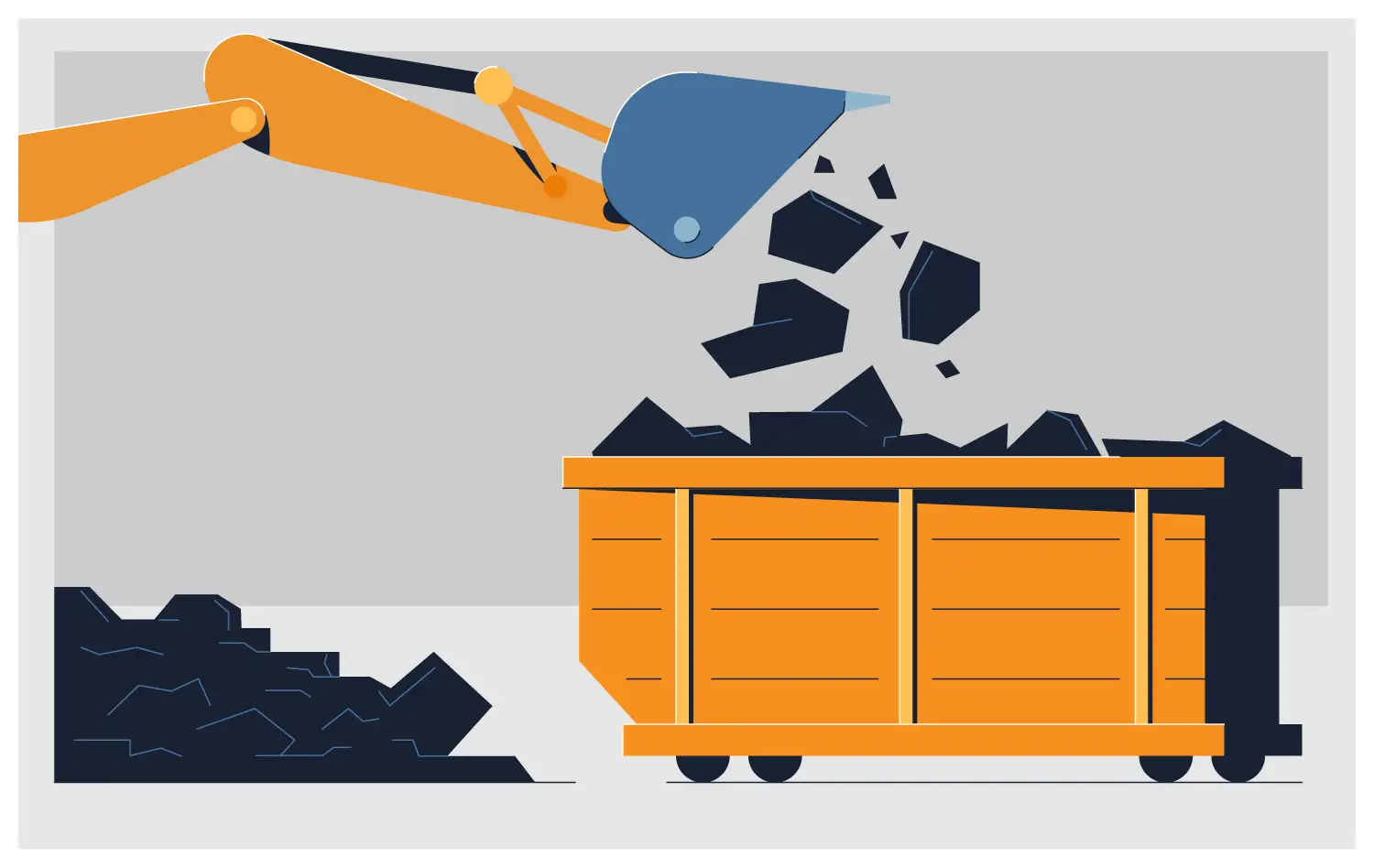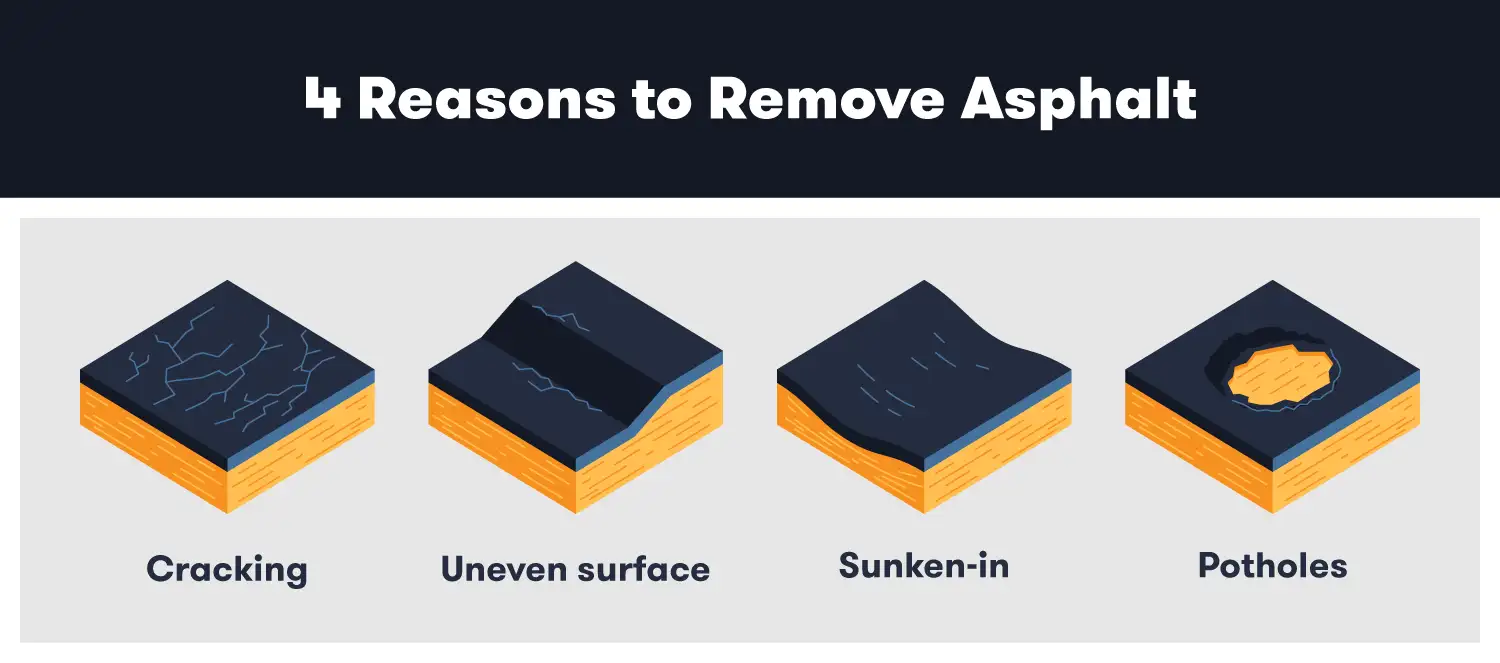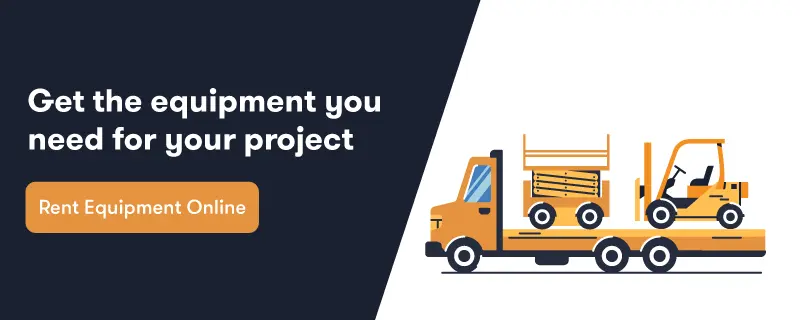Even with proper care and maintenance, all asphalt eventually needs replacing. Most asphalt lasts between 20 and 30 years, but cracks, potholes and other damages can occur, making the asphalt unsafe and unsightly. If you have a project that includes asphalt removal, you can call a company to remove it for you or you can learn to do it yourself. In this article, we’ll go over some of the average costs to hire a concrete removal contractor. We’re also giving you a step-by-step asphalt removal guide to remove it yourself using three methods, ranging from using an excavator to handheld tools.
- How To Remove Asphalt Yourself in 3 Steps
- Average Cost of Removing Asphalt
- Cost Factors of Asphalt Removal
- Asphalt Removal FAQ
- Rent Excavators for Asphalt
How to Remove Asphalt Yourself in 3 Steps

If hiring an asphalt removal company is out of your budget, you may be able to remove the asphalt yourself for a lower price. Even if you don’t own the right equipment, you can rent your equipment for a daily fee that may cost less than a hired hand. If you choose to carry out the project yourself, keep reading for a step-by-step guide on how to remove asphalt yourself using the most common methods.
Step 1: Determine What Equipment You Need
Asphalt removal can be accomplished in various ways. In this first step, take the time to evaluate the project and determine what method you will use to carry out the project and the tools and equipment you will need.
Key takeaway: Taking the time to survey your project and determine the right method for asphalt removal will save you time and money. As a rule of thumb, the larger the project, the larger the machinery you should use.
- Removing the asphalt with hand tools. If the asphalt is contained to a small area, or if you’re simply removing a small portion of the asphalt, you may be able to remove the asphalt with handheld tools. If you prefer a non-powered tool, you can use a pickaxe. With the right amount of force, you can break up the asphalt and pry it up from the ground. You can also use a circular saw fitted with a concrete or masonry blade to break up and cut the asphalt into smaller pieces.
- Remove asphalt with a jackhammer. A jackhammer is a larger piece of machinery that would also work in the asphalt removal process. A jackhammer combines the forces of an electric hammer and a chisel to break slabs of material into smaller pieces. It’s an excellent tool for a project requiring more work than one can accomplish using the previous method.
- Remove asphalt with an excavator. If you’re working on a large project where you’ll be removing a large surface area of asphalt, like an asphalt driveway, you may consider using an excavator. With the right type of excavator, your project can move along quickly and efficiently. Using the excavator, you will use the teeth on the bucket to break apart and pry up the asphalt. Just note that the use of an excavator may require specialized training.
Pro tip: No matter the method, you should always wear the right safety and protection gear. When on the worksite, always wear work boots, a hard hat, work gloves, eye protection and ear protection.
Step 2: Break and Remove the Asphalt
Once you’ve determined the right method to remove the asphalt, you can use the tool to break up the asphalt. As the surface breaks apart, it will also lift from the ground below it, making it easy to lift and remove from the surface.
For an asphalt resurfacing project where you’d only remove part of the asphalt, you can use the circular saw or jackhammer method to break through it. Next, you can lift and dispose of broken asphalt and then refill and repair the surface.
If you’re working on a larger project and using an excavator, you should start in places where the asphalt is already compromised. Starting here will make it easier for the excavator to break through the asphalt and begin the excavation process.
Using the teeth of the excavator bucket, begin breaking up the asphalt by digging them into the surface. Then, using sweeping motions toward the excavator cabin, lift the asphalt from the ground. As you work, use the excavator bucket to scoop up and move the pieces of asphalt out of your way.
Pro tip: For your safety and to prevent unnecessary damage, be aware of your surroundings. If you’re working near buildings, power lines or another structure, use a jackhammer or a hand tool to remove the asphalt closest to the structure.
Step 3: Properly Dispose of the Removed Asphalt

As with any construction project, proper disposal of materials is essential. City waste management services often won’t take discarded construction materials, so it’s your responsibility to deal with the waste.
Many construction sites rent a dumpster and haul it to the local dumpsite at the end of the project. However, asphalt can be easily recycled and repurposed. So instead of simply dropping off the old asphalt at the landfill, do a quick internet search to find asphalt recycling centers near you. Some services may even offer pickup for the construction site, saving you a trip.
Pro tip: You can use Recycle Nation’s tool to find a recycling location near you. Quickly type in your collection method, location and the material you wish to recycle to find businesses and recycling centers near you.
Average Cost of Removing Asphalt
Most companies charge by square foot, ranging from one to three dollars per square foot. Companies set their rate based on various factors, many of which we’ll discuss in the next section.
To figure out a more accurate cost, try calling local concrete removal companies. You can give them some background information on your needs and the project you’re working on, to which they can respond with a cost estimate based on their pricing.
Cost Factors of Asphalt Removal
When hiring a contractor for a pavement removal project, there are various factors involved in how much they’ll charge you. For example, if a project proves more difficult than the average project due to limited workspace or other hardships, it may cost you more than expected. These are the most common factors that will affect the cost of your project:
- Square footage. Most companies charge by the square foot, so the larger the surface area, the higher the cost.
- Ease of access. Many pavement removal companies use heavy machinery to remove asphalt. If there is a lack of space to work or the company has to spend more time and money arriving at your worksite, they may charge you more.
- Difficulty of removal. Some projects may prove to be more difficult than others for several reasons. While businesses charge by square footage removed, they can charge a heightened rate if the job takes longer than expected.
- Living costs in your area. If you live in an area where living expenses are higher than average, you’ll likely pay more than if your project were located elsewhere due to inflated rates.
Asphalt Removal FAQ
When working with asphalt, you may have a few follow-up questions. Here are the answers to the most frequently asked questions about asphalt removal.
Why Should I Remove Asphalt?
Asphalt wears down over time and becomes affected by the elements, like rain and sunlight. As the asphalt’s composition deteriorates, it can become unsightly and, more importantly, unsafe. If you notice any of the following issues with your asphalt, you should consider repairing it or removing and replacing it entirely.
- Deep cracks in the surface
- Unevenness
- Areas that are sunken-in
- Potholes

What is the Best Way to Remove Asphalt?
The best way to remove asphalt depends on the size of the project and the tools you are most comfortable using.
For projects that require removing a large surface area, the most efficient way to remove the asphalt is through an excavator. The use of an excavator may require special training, so if you’re unfamiliar with how to operate an excavator, perhaps another method would be more suitable.
Smaller projects are possible with the use of a jackhammer or a circular saw with masonry or concrete blade. With these tools, you can either break or cut through the asphalt to create smaller pieces of asphalt, then lift and remove it from the surface below.
The last way to remove asphalt is through the use of hand tools, like a pickaxe, to break down the asphalt. This method is only recommended for small projects since it can be fairly inefficient when compared to using power tools or an excavator.
When is the Best Time to Remove Asphalt?
Cracks, potholes and other unsafe asphalt problems can only worsen if left unaddressed since elements like rain and snow can get under the asphalt and change the surface beneath it, leading to further damage.
When cracks and potholes are one to two inches deep, asphalt removal is necessary to ensure safety for those driving or walking. If the asphalt breaks apart to create an uneven surface, remove and replace it as soon as possible.
How Many Years Does an Asphalt Driveway Last Before Needing to Be Replaced?
Most asphalt driveways last between 20 and 30 years before needing to be replaced. But the longevity of asphalt depends on various factors like upkeep and climate. The pavement may become brittle in dry climates, while in humid areas, moisture can build up beneath the asphalt, causing it to weaken.
Maintenance is another important factor when it comes to the longevity of asphalt. Try to reseal asphalt every three to five years and, in extreme weather environments, every two to three years. Frequent resealing protects the asphalt and keeps the elements from damaging it. Other important maintenance, like filling and sealing cracks and potholes, will also help maintain a long-lasting asphalt driveway.
Should I Use Concrete or Asphalt for My Driveway?
While asphalt and concrete are both paving materials, they are also different in various ways. Both materials have pros and cons, so it’s important to compare and contrast them and weigh what’s most important for you.
For example, concrete is more expensive than asphalt, but it can last longer. Concrete has a more custom aesthetic, whereas asphalt only appears one way. Both materials require maintenance, with asphalt requiring frequent resealing and concrete occasionally requiring degreasing. Here is a full list of the pros and cons of concrete vs. asphalt driveways.
Rent Excavators for Asphalt Removal
Now that you know how to remove asphalt yourself, you’re ready to tackle this next project like a pro. And if you lack the right equipment, consider renting it! Renting construction equipment is a cost-effective way to access the equipment you need now but don’t need to own.
BigRentz offers rentals on excavators, earth-moving equipment and other heavy equipment for asphalt removal and other construction projects. With service areas across all 50 states, we make renting equipment online easy so you can quickly start on your future construction projects.
